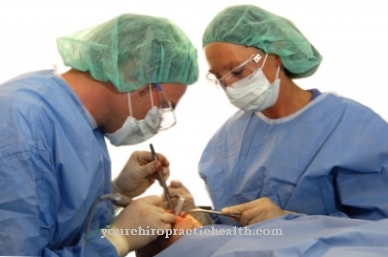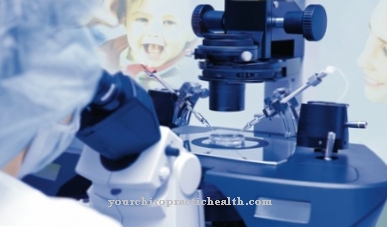Is a Chemoprophylaxis If induced, the medical professionals administer a virustatic or an antibiotic to the patient in order to treat an established or an impending infection prophylactically (preventive). With the allocation of these drugs, the spread of pathogens in the body is to be prevented or combated.
What is chemoprophylaxis?

There are various forms of prophylaxis available to doctors: according to the microorganism, time of use and indication. Chemoprophylaxis includes drug protective measures in the form of tablets or vaccinations. These treat an existing infection or prevent it if the pathogen has not yet spread in the human organism.
The drugs kill the pathogens in the blood, provided the patient is not resistant to the substance used. Tablets cannot prevent some types of infection, such as malaria, but they can kill the pathogens. With the increasing number of pathogen resistances, a residual risk remains with some infectious diseases, since there is no complete drug protection. The allocation of the right medication depends on the patient's individual factors such as health, age, previous illnesses, resistances and any allergies to individual components of the substances.
Function, effect & goals
If the indication is based on a microorganism, the physician will administer antibacterial and antiviral chemoprophylaxis. According to the time of use: With the pre-exposure prophylaxis, patients suffering from an HIV infection take antiviral drugs to avoid a risk situation, e.g. B. unprotected sex, to switch off or at least to minimize. Post-exposure prophylaxis (PEP) is administered to patients when they are contaminated with pathogens in order to prevent further spread in the organism.
Such an infection can occur, for example, in hospitals when there is contact with insufficiently sterile equipment such as a syringe. In addition, the infectious disease must be prevented from spreading to other people. This type of prophylaxis takes the form of anti-virus drugs or antibiotics. Vaccination is also possible if the patient is at risk of rabies from being bitten by an animal. In the case of surgical interventions and operations, perioperative chemoprophylaxis prevents the inflammation of larger wound areas and the infiltration of pathogens (germs, bacteria) into the bloodstream. Malaria prophylaxis takes place according to the time of indication in order to prevent infection with the malaria infection. Exposure prophylaxis protects against the transmission of diseases by insects. Stand-by prophylaxis has a long-term effect.
Patients who have recurrent infectious diseases of the urinary tract are treated with antibiotics. Chemoprophylaxis is used for various diseases and pathogens: tuberculosis, malaria, meningitis, pertussis (whooping cough) and meningococci. Meningococcal diseases (Neisseria meningitidis) occur when the pathogens settle in the nasopharynx. People with a healthy immune system show no clinical symptoms when these pathogens are present. The body is able to break down these pathogens on its own. The pathogens die off quickly outside the focus of infection, which is why very close interpersonal contact and the transmission of oropharyngeal secretions are necessary for transmission and infection. The disease takes the form of meningitis and is usually characterized by sepsis.
In particularly severe cases, septic shock can occur. Headache, chills, fever and a severe feeling of illness are the side effects. The mortality rate is particularly high in infants, young children and the elderly. Meningitis can lead to irreversible brain damage. In severe cases, septic disease can cause persistent disability, limited necrosis, and extensive limb gangrene. Meningitis can lead to cerebral palsy, seizures, hemiplegia, damage to the inner ear, deafness, impaired intellectual ability, and hydrocephalus.
The mortality rate in Germany is 1 percent in the presence of meningitis, with an additional septic course the mortality rate increases to 13 percent, in the case of Waterhouse-Friderichsen syndrome to 33 percent. The whooping cough disease caused by the pathogen Bordetella pertussis has been largely contained through regular vaccinations in childhood. However, every four to six years there is a more cyclical increase in pertussis. A reporting requirement was introduced in 2013. The infection with the pathogen occurs through the respiratory tract, the multiplication leads through the mucous membranes. A large number of toxins worsen the defenses of the immune system. The disease is characterized by cough, fever and weakness.
The wheezing that is typical of the disease occurs due to the sudden inspiration of a closed glottis as the seizure draws to a close. Tuberculosis is an infectious disease that is spread around the world. It is caused by mycobacteria and mainly affects the lungs. It can spread to other organs and the respiratory tract. This disease leads the world mortality statistics. Infection occurs through droplet infection, as with common colds. If germs are found in the sputum, open tuberculosis is present. If external body secretions are carriers of the germs, doctors speak of potentially open tuberculosis.
Risks, side effects & dangers
The prophylactic use of antivirals and antibiotics is induced only in rare cases in order to avoid serious infectious diseases. Prophylaxis is mainly used for diseases for which vaccination is not possible and preventive measures are useful, such as malaria.
Chenin, chloroquine, mefloquine, hydroxychloroquine, atoquavone and proguanil are used as drugs. Meningococcal infection is treated with penicillin G. However, before they are discharged from the hospital, the patients receive additional therapy with ciprofloxacin, rifampicin or ceftriaxone, since the antibiotic alone does not kill the pathogens. Eradication of whooping cough is still not possible, as vaccinated people can also get sick. For basic immunization, anticellular vaccines are available that are combined with antigens. The chemoprophylaxis is based on macrolides. Tuberculosis diseases are treated with drugs that are specifically used for these pathogens, which is why they are called antituberculotics.
The award takes place in the form of a primary prophylaxis. Children receive 200 mg / m2 BSA and adults 300 mg / day isoniazid. The use of prophylactic medication can lead to resistance of the medication used, which complicates the treatment. So far, there is only one government recommendation for treatment with chemoprophylactic drugs: for employees who come into regular contact with poultry and who are at risk of contracting avian influenza or avian flu.
It is recommended that employers provide their employees with chemoprophylaxis with neuraminidase inhibitors.Preventive treatment with oseltamivir phosphate (Tamiflu) as protection against bird flu and influenza is also possible if sufficient influenza vaccine is not available.













.jpg)

.jpg)
.jpg)











.jpg)